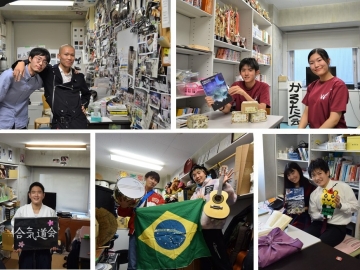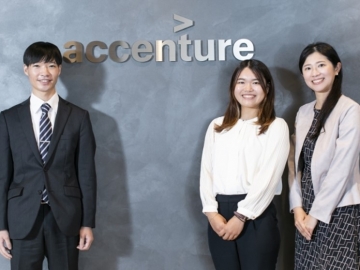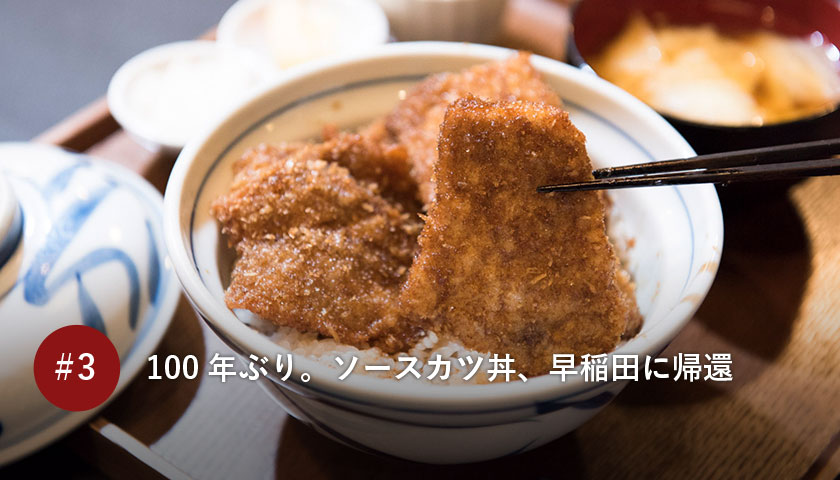
Sauce Un’s sauce katsudon
Katsudon is taking flight and becoming a global delicacy. Since the birth of Yo-roppaken’s sauce katsudon in Waseda in 1913, the dish has gone on to become a specialty in Fukui Prefecture, but disappeared from Waseda without a trace following the restaurant’s relocation. However, in May 2016, approximately 100 years after its creation, sauce katsudon returned to Waseda’s Tsurumakicho at a restaurant located at Yo-roppaken’s former address. The restaurant is called Sauce Un. Sauce Un’s owner, a native of Fukui Prefecture, learned the history of Japan’s “first katsudon” and decided to open a restaurant at its birthplace.
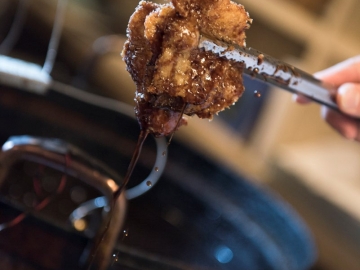
“Wase-katsudon” consists of crispy tonkatsu drenched in sweet sauce
“I want to spread Japanese culinary culture to the world,” says Sauce Un’s owner, Takehiko Mori, who can be seen preparing katsu near the store’s entrance. “I think one aspect of Japanese culture is how overseas culture makes its way to Japan and fuses with elements of traditional Japanese culture. With its tonkatsu and bowl of rice topped with worcester sauce, sauce katsudon is a staple of Japanese cuisine.”
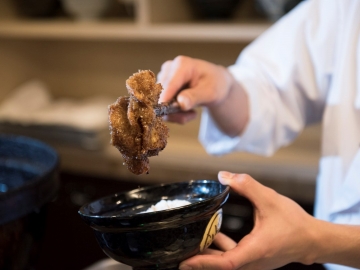
Sauce drips from the tonkatsu onto freshly prepared, warm rice
“I coined the dish ‘Wase-katsudon’ because it was born in Waseda and can be prepared quickly. Sauce katsudon, which originated in Waseda and later became a specialty of my hometown in Fukui Prefecture, is fit to become a global delicacy. I’m currently preparing to open a restaurant overseas.”
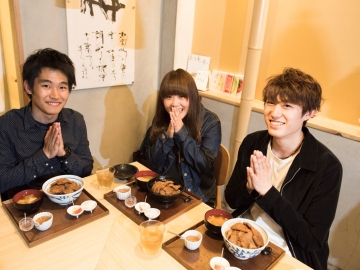
Hokuriku Student Club members Sakai, Nanbu, and Nakamachi excited to eat Wase-katsudon
We invited Hokuriku Student Club members and Fukui natives Takumi Sakai (third-year student at the School of Human Sciences), Ayano Nanbu (third-year student at School of Culture, Media, and Society), and Ryosuke Nakamachi (third-year student at the School of Commerce) to verify the taste of Sauce Un’s sauce katsudon.
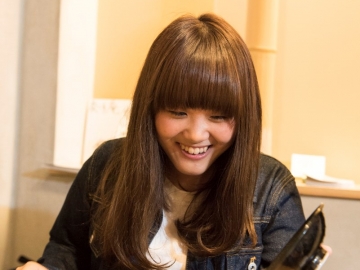
One cannot help but smile at the sight of one’s “soul food”
These three students make it a point to eat Yo-roppaken’s katsudon every time they return to Fukui. They are dyed-in-the-wool sauce katsudon fans. “I ate it three times in one week last time I went back” says Sakai. Nanbu comments, “I only found out about egg-bound soup katsudon on TV,” and Nakamachi says, “I’ve never eaten egg-bound soup katsudon.”
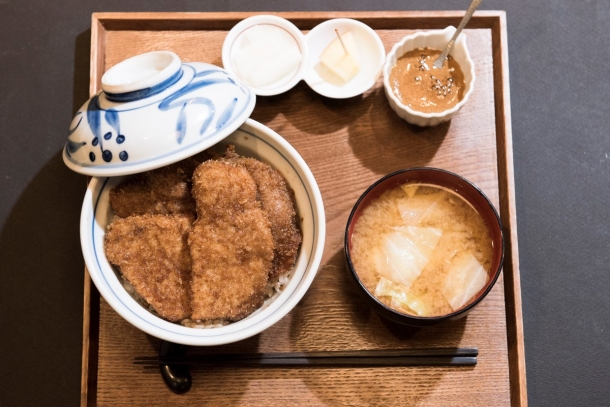
“Wase-katsudon”
The three characteristics which distinguish “Wase-katsudon” are its tonkatsu, short preparation time, and sauce in which the tonkatsu is drenched. The three students deliciously bit into the two slightly thick slices and three thin slices of tonkatsu topping the restaurant’s staple dish.
Each of them shared their impressions.
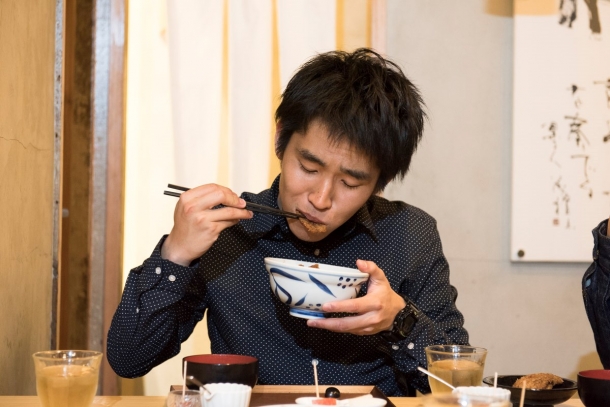
Sakai biting into Wase-katsudon
“My way of eating sauce katsudon is to first move the tonkatsu to a separate plate and eat just the rice and sauce. I have some friends who are international students so I want to bring them here and expand this flavor to the world. I think sauce katsudon would be popular,” says Sakai.
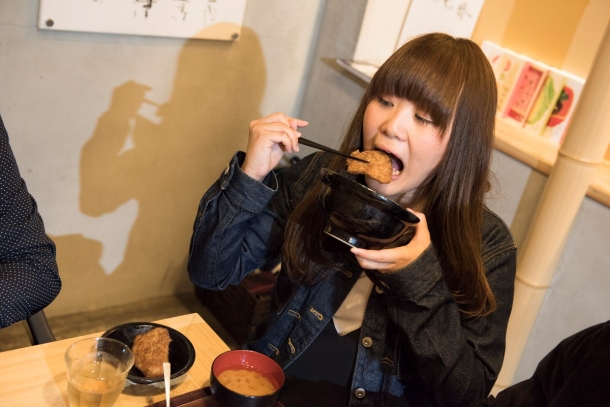
Nanbu biting into a mouthful of tonkatsu
“When it comes to katsudon, the tonkatsu needs to be soft and thin. I am proud my soul food’s roots can be traced to Waseda. Right now some friends and I are planning to start a club centered on bringing back Waseda’s culture from the past. Sauce katsudon will definitely be a part of that,” says Nanbu.
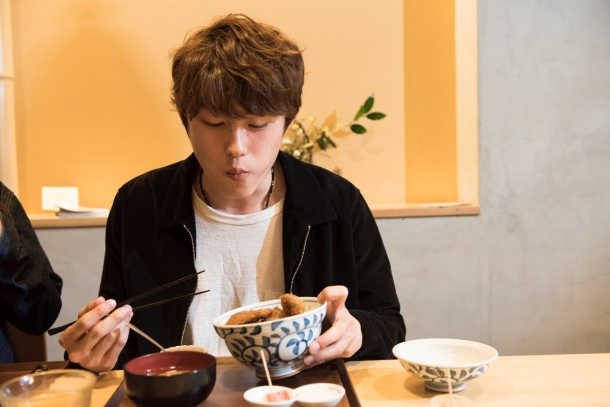
Nakamachi as the taste of his hometown spreads to his stomach
Nakamachi says, “It doesn’t just taste good, it makes me happy. The katsudon served at the soba restaurant in my hometown is, of course, sauce katsudon. I grew up eating this so I’m relieved there’s a place in Tokyo where I can eat it. There are a lot of international students at Building 11, which houses the School of Commerce, so I will try to introduce them to this staple of Japanese cuisine.”

The three scarfed down wase-katsudon without resting their chopsticks
In the first part of this special we looked back on the Waseda-born katsudon’s history. In the second half we shared the latest developments surrounding katsudon. Katsudon, the worlds of anime, and major restaurant chains are spreading their wings and soaring across the world, just like Waseda University.
Katsudon is finding its place around the world. Waseda University has been conscious of the world outside of Japan since its founding in 1882. In its second year, Waseda University accepted its first international student, and currently, over 130 years later, there are 5,400 international students, the most of any university in Japan. Perhaps it was inevitable that katsudon’s Waseda roots would bring it to the rest of the world.
The phrase “all the world’s roads lead to Waseda” appeared in the November 16, 1966 edition of Waseda Weekly, in which the first Waseda University Library Director, Kenkichi Ichijima, wrote about the prominent individuals from around the world who visited Okuma Shigenobu’s residence and spoke at Waseda University. A play on “all roads lead to Rome,” this phrase befits katsudon’s part in Waseda’s history.
All katsudon leads to Waseda…
English translation: Joachim Muntal

